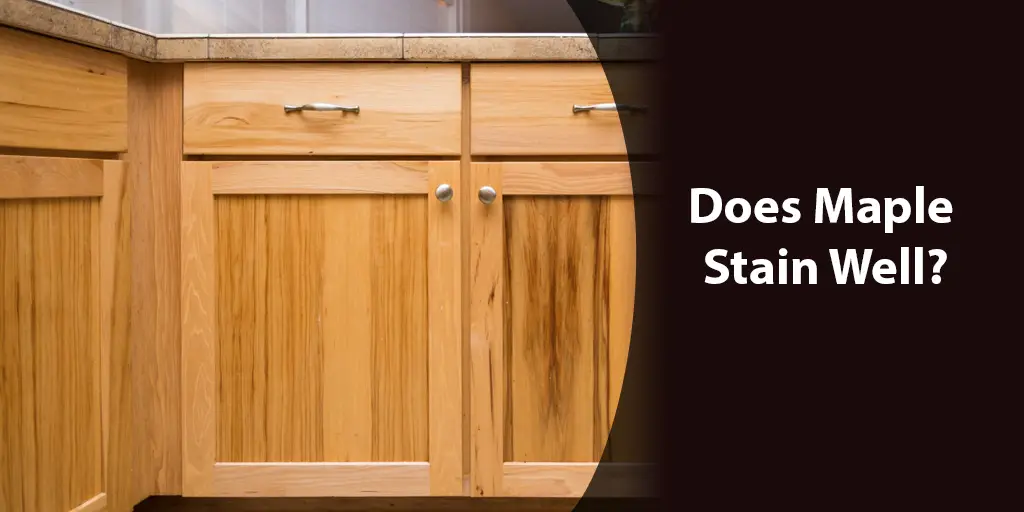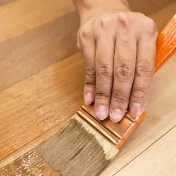Staining maple wood to highlight its natural beauty is a challenge many woodworkers and DIYers have faced.
Maple’s tight grain structure does not absorb stain uniformly, often resulting in unsightly blotches or an uneven finish. But with the right techniques and materials, it is possible to stain maple beautifully.

In this comprehensive guide, we will break down everything you need to know to stain maple like a pro.
We’ll start with the basics – what makes maple difficult to stain compared to other wood varieties. Then we’ll explore essential preparation steps like sanding and using pre-stain conditioners.
Next is a detailed overview of stain types and how to choose the best one for your maple project. We’ll also cover application methods and tips for avoiding common pitfalls.
Troubleshooting advice is included for issues ranging from blotchy stain to an uneven color.
For those seeking to fully transform the look of their maple wood, we’ll share methods for achieving darker hues. Finally, frequently asked questions about staining maple will be answered to address additional reader concerns.
By following the best practices outlined here, even novice woodworkers can expect professional results. Maple’s inherent challenges need not discourage you from taking on this rewarding process.
With patience and the right approach, your hard work is sure to showcase maple’s exquisite grain while maintaining its natural beauty for years to come.
Is Maple Easy to Stain? The Truth About This Notorious Hardwood
When it comes to staining wood, most woodworkers consider maple one of the hardest varieties to work with.
But why exactly does maple have a reputation for being difficult to stain evenly? The answer lies in its unique grain structure.
Maple is prized for its attractive grain patterns and strength qualities. However, its tight cell structure makes for a very dense wood. This causes maple’s pores to be incredibly small compared to more porous woods like oak.
The tightness of maple’s grain presents two major issues for staining. Firstly, stains have difficulty penetrating deep into the wood like they can with open-grained woods. As a result, the stain may not absorb fully and uniformly.
Another problem is that maple’s grain is not consistent in density. Areas of earlywood growth tend to be less dense than latewood rings.
When stain hits these natural variations, it often soaks in at different rates – leading to blotchy dark and light spots.
So in summary, while maple’s grain hardness makes it durable, it also works against achieving an even stain finish.
The non-uniform absorption leaves far less room for error compared to easier-to-stain woods. This is why preparation and technique is key to overcoming maple’s notorious staining challenges.
In the following sections, we will explore the proper methods for preparing maple’s closed grain and applying stain strategically to overcome its natural tendency towards blotchiness. With the right approach, maple can indeed take stain beautifully.
The Challenges of Staining Maple
While maple’s tight grain structure is largely to blame for its difficulty taking stain evenly, there are a few more specifics worth understanding.
Knowing precisely what makes maple finicky can help woodworkers tailor their approach accordingly.
Let’s examine two key challenges in more depth:
Non-Uniform Grain Density
As noted, earlywood and latewood rings in maple differ in porosity. Earlywood tends to have larger openings that allow deeper stain penetration and darker color saturation.
Latewood’s compact fibers resist stain more, appearing lighter. These natural variations become visible as mottled patches under stain.
Tight Grain Closure
At the microscopic level, maple’s cell walls are exceptionally thick. This leaves little room between each cell for stain molecules to penetrate.
Along with its non-porous nature, maple’s grain essentially slams the door on stain – rebuffing attempts at uniform absorption across the surface.
There’s also the concentric swirl pattern of maple’s grain lines to consider. Any deep scratches or uneven sanding that follow these spirals may similarly not stain to the same darkness as surrounding areas.
Now add in wood defects like voids or spots with unusually dense grain, and it’s no wonder maple keeps woodworkers on their toes!
Overcoming such intricacies demands preparation, precision and patience during staining. The right technique counters each challenge maple poses naturally.
Armed with this deeper insight into maple’s grain traits, readers can better understand why special care is needed for attaining an even stain result. Stay tuned for our full methodology on taming this complex wood’s staining woes.
The Importance of Proper Preparation and Technique
Given the challenges inherent to maple’s intricate grain structure, success requires taking a strategic approach.
Shortcuts will not do; only fastidious planning and execution can conquer this wood’s staining conundrums.
Proper preparation acts as the foundation, leveling inconsistencies for an even canvas. As with any project, sanding deserves top billing here.
Working stepwise from coarse to fine-grit paper produces a silky-smooth surface optimizing stain flow.
Pay heed to any defects like scratches or knots, remedying them before moving to the next grit. Checking frequently prevents unwanted swirls. A vacuum afterward removes all dust, critical for subsequent steps.
Next up is pre-conditioning, an oft-overlooked yet crucial staging process. By regulating maple’s absorption variability, conditioners normalize its response to stain application. Oil or water varieties suit your needs; test first to avoid issues.
Allow adequate drying then lightly sand to seal the primed surface. You’re now ready for staining – but retain that perfectionist mentality. Only unwavering technique will penetrate maple’s defenses.
Work in small, controlled sections and maintain an even touch. Neither rush the application nor linger too long in one spot. Swift, feathery strokes parallel to the grain prevent inconsistencies.
Wiping promptly after the recommended dwell time catches drips before they settle. Implementation is half the battle; with the tailored plan and delicate hand outlined here, your efforts are sure to reward.
Choosing the Right Stain for Maple Wood
With so many stain options crowding shelves, selecting the right one can feel overwhelming. But understanding key attributes streamlines the decision. While any quality product can work, some simply pair better with maple’s nuanced grain.
Let’s break down the top two stain types:
Oil-based and water-based. Oils offer deeper, richer hues but lengthen drying time. Their emollient texture penetrates maple superbly though. Water stains are faster drying with less odor or toxicity, but may not level grain as well.
Gel stains emerge as the woodworker’s best friend. Developed specifically for finicky woods like maple, their thick yet smooth consistency glazes evenly atop the surface. Less is absorbed into the nooks where blotches lurk.
Dye stains also foster uniformity through microscopic pigment size. More deeply infused than traditional stains, they accentuate minute variations with harmony rather than high-contrast stripes.
Brand reputation plays a part too. Industry stalwarts like Minwax and General Finishes undergo rigorous testing to deliver dependable performance. Their diverse color palettes satisfy any style or wood tone goals.
Armed with this primer, choose the product befitting your project needs. Gel or dye likely yields best results, but test first to feel the hand of different options on your maple. With the right match, stained success awaits!
Does Maple Need to Be Conditioned Before Staining?
For years, conventional wisdom dictated conditioning maple prior to staining as best practice. But does this extra step truly make a difference, or is it just extra work?
Let’s take a deeper look at why pre-treating maple’s surface deserves as much attention as other preparation methods.
On a microscopic level, conditioners work to level maple’s uneven topography. By partially sealing the wood, they regulate its absorption so some areas don’t drink up too much dye while others stay parched. This fosters an even dye saturation beneath.
Without pre-conditioning, differences between earlywood and latewood rings emerge starkly under stain.
But properly sealed, their pigment uptake balances like a fine mosaic. Pores also close just enough to moderate liquid penetration yet still permit an opaque, consistent tone.
Conditioners come in oil and water formulas to suit any stain type. Oil varieties bond wood fibers while water-based formulas clean up easily. And while DIY recipes work, commercial products ensure tried-and-true performance.
The payoff far outweighs mere minutes spent applying a conditioner layer. Without its pore-filling magic, excessive sanding between stain attempts may still not fully tame maple’s blotchiness. Condition first for a seamlessly colored canvas requiring minimal rework.
When staining notoriously fickle woods, leaving no preparation stone unturned forms the soundest strategy. Consider pre-conditioning an essential step for tackling even staining’s toughest subject – maple.
How to Prepare Maple Wood for Staining
With maple’s closed grain primed for stains through conditioning, focused surface preparation unlocks an optimal canvas.
Simply rushing in risks flaws appearing post-finish. But executing each step precisely readies maple’s natural beauty.
First up, addressing defects. Fill porous knots or cracks to eliminate wicking issues. Sanding then erases filler excess for a seamless transition.
Use progressively finer (120-220) grit paper in uniform strokes, sanding with rather than against the grain’s elegant contours. This buffs out irregularities while maintaining character.
Vacuuming thoroughly extracts residue between steps. Even microscopic dust particles may interrupt an even dye flow at stain time.
Skilled crafters also examine grain patterns for variances demanding extra attention. Swirls or sunbursts necessitate delicate abrasion to safeguard an headache-free final appearance.
With flaws and inconsistencies eliminated, maple gleams brighter than ever. Its closed cell structure now waits expectantly for stain to seep within, producing vibrancy without defect or patchiness.
Proper preparation uplifts any material’s beauty – and none more so than temperamental maple. Woodworkers who nourish its natural tones reap muse-worthy results worthy of gallery walls for years to come.
How to Stain Maple Wood
After diligent preparation lowering maple’s resistance to stains, it’s time to color its cells with care. Only precision will unlock an evenly toned masterpiece. Follow these exacting steps for success:
Start by stirring the stain thoroughly, ensuring pigments mesh homogeneously. Unmixed dye leaves patches where some spots over-saturate.
Set up twin foam brushes: one for stain application, one to remove excess. Work small sections at a time to focus attention. Maple demands focus; rushing spells trouble ahead.
As with sanding, use gentle brushstrokes with rather than against the grain. Flood cells fully without excess dripping or lying in recessed rings.
Let stain penetrate five to ten minutes as per instructions. Longer depths the color; shorter leaves a natural satin sheen.
Swiftly wipe off surplus pigment before it begins to set. Remove in grain-direction only to maintain an unbroken surface sheen.
Repeat the process section-by-section until complete. Seal and buff to a radiant luster.
Additional coats yield a deeper, darker result. Sand lightly between to ensure proper bonding to wood fibers.
With minute adjustments based on each piece’s peculiarities, maple’s true hues shine forth as though brought to light. Precision staining primes nature’s talent.
Tips for Staining Maple
With the right strategy, even woodworking novices can stain maple to pro standards. Some additional pointers smooth potential pitfalls:
Sand parallel to grain lines using progressively finer grits. This preps the surface while retaining texture.
Thoroughly mix stain before each use. Unblended pigments may pool unevenly.
Work in a well-ventilated space and wear protective equipment. Fumes from oil-based products are no joke.
Test stain color on scrap wood first. Getting the desired hue requires experimenting on less-important pieces.
Apply stain liberally but not excessively. Too wet or thin a coat risks uneven dye uptake across the surface.
Wipe away excess residue promptly using soft, lint-free rags only in the direction of the grain.
Consider pre-conditioning even if staining gel or dye products. It provides an extra insurance blanket against blotches.
Allow full curing time between tandem stain coats to bond each layer perfectly.
Seal the finish properly once fully dry using a topcoat formulated for interior wood. Natural oils suit maple.
With these best practices reinforcing standard methods, you too can capture maple’s elusive grain and gorgeous tones with confidence. Approach unknown woods armed only with patience and these guidelines. Staining success will follow your careful path.
Troubleshooting Staining Issues
Even experienced woodworkers hit snags now and then when staining temperamental maple. But don’t despair – simple fixes overcome most problems. Identifying symptoms leads straight to remedies.
For blotchy results, initial preparation likely needs attention. Try re-sanding or adding another round of conditioning to furtherlevel absorption. Visible swirls may require stain mixing or application revisions.
Should color seem uneven, the culprit is usually insufficient stain soaking followed by hasty wipe-off. Redo with longer dwell times to saturate more deeply before buffing away residue.
If streaks emerge mid-job, pause and evaluate brush type and stroke direction. Switching to foam or changing grain alignment could solve it. Old or improperly stored stain also causes streaking; replace it.
Light spots where grain pops through may be due to scant stain application or coarse previous sanding. Simply add a second coat after light sanding between for full coverage.
With experience comes instincts for any issues. But don’t hesitate trying conservative remedies initially or consulting online communities. Through identifying and addressing problems confidently, staining mastery is yours to claim.
Stain Types and Colors for Maple
Selecting the ideal stain to complement maple’s inherent beauty requires understanding how various dye shades interact with its grain structure. Some produce warmer undertones while others yield crisper contrast.
Light stains allow maple’s character to shine through with subtle accenting. Honey, butterscotch and amber tones warm up its luster. Ideal for furniture where natural woodgrain takes center stage.
Medium shades like espresso, walnut and merlot deepen definition between earlywood and latewood bands. Draws eyes slowly across ripples and swirls. Pairs beautifully with transitional decor.
Dark walnut, ebony or graphite intensifies closed-grain areas while leaving open portions gracefully light, popping out intricate patterns. Statement-making yet not overpowering, it defines architectural details.
Distressed stains further antique the appearance. Slate grey, platinum or weathered brown washes of pigment give an heirloom look whether mildly or vigorously thinned.
No matter the final product, sample patches ensure accurate color translation from stain to wood. Nuances change drastically with variations in density, coat thickness and brand. Test enthusiastically!
With limitless colorways to experiment, identifying optimal hues transforms stunning maple into unforgettable works of art for generations.
Read Also: Does Epoxy Stick to Melamine? (Explained in Details)
Answers to Frequently Asked Questions
Even for the seasoned woodworker, staining maple consistently poses questions. This FAQ section addresses common concerns and unknowns:
Can I stain maple without sanding first?
Not recommended. Sanding removes milling marks and equalizes grain for uniform stain absorption. Skip at your own risk of blotchiness.
Is it okay to stain maple with the grain?
No, you must stain in the direction of the grain lines to avoid color variations. Going against them risks uneven dye deposits.
How many coats of stain does maple typically need?
A: Most pieces require two coats minimum. But test patches first – open-pored maple may saturate fully in one, while denser varieties demand additional layers.
What’s the best way to remove old stain from maple?
A: For light stains, sanding may suffice. But thicker old finish needs a stripping agent like mineral spirits, taking care not to damage underlying wood.
Can I topcoat stained maple with polyurethane?
Yes, a wipe-on or brushed poly finish protects stained maple nicely indoors. Opt for water-based formulas when possible for lower toxicity.
How do I get an especially dark stain on maple?
Multiple thin coats yield deeper color with less risk of blotchiness versus one heavy application. Consider a gel or dye stain too.
With diligence in prep, materials and methods, even the trickiest staining tasks become clear. Approach unfamiliar woods with confidence after mastering the maple challenge!



